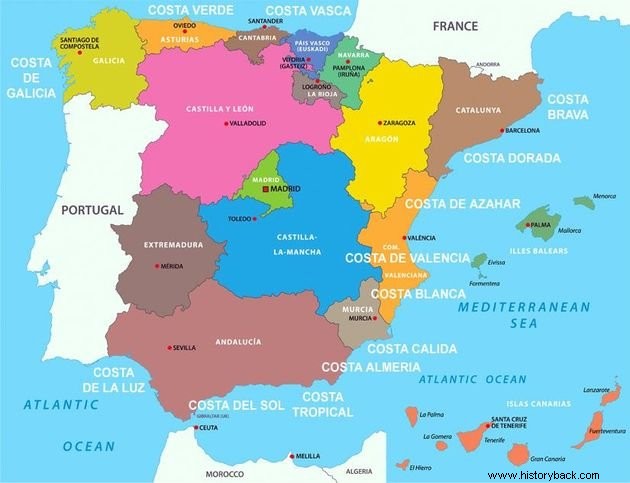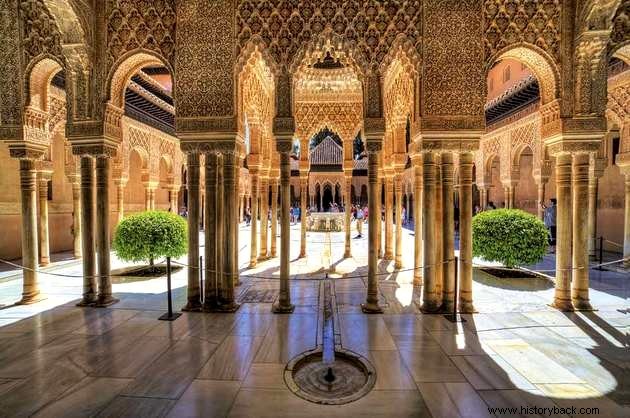Spain , whose official name is the Kingdom of Spain, is a country located in the Iberian Peninsula.
After a 20th century marked by a Civil War and a forty-year dictatorship, democracy returned to Spain in 1975 and the country joined the European Economic Community in 1986.
General Data for Spain
- Capital :Madrid
- Population :46,549,045
- Surface :505,940 km 2
- Demographic density :92 inhabitants per km 2
- Government Regime :parliamentary monarchy
- Head of State King Felipe VI - since June 19, 2014
- Head of Government :Pedro Sánchez - since 2018
- Language :Castilian or Spanish plus four co-official languages:Basque, Catalan, Galician and Aranese
- Currency :Euro
- HDI :0.884
- Religion :Christianity and Islam
Map of Spain
Spain is divided into 16 Autonomous Communities and two autonomous cities, Ceuta and Melilla. In the map below, we can see the division of the communities and their respective capitals highlighted in bold.

Main Cities
- Madrid
- Barcelona
- Seville
- Valencia.
Borders
- Portugal
- France
- Andorra
- Morocco
- United Kingdom through the overseas territory of Gibraltar
Flag of Spain
The Spanish flag has two horizontal red stripes and a horizontal yellow stripe in the center. There is also the monarchic shield that bears the motto Plus Ultra (Further ).
 See also:Flag of Spain
See also:Flag of Spain Politics in Spain
the century XX was quite troubled for Spain. A group of opponents overthrew the monarchy and proclaimed the Second Republic in 1931, but five years later, the Army, led by General Francisco Franco, declared war on this government.
A Civil War ensues for three years with the victory of the Nationalists. General Franco installs a nationalist dictatorship, with characteristics of fascism such as censorship, banning political parties and where there were no elections for head of state or government.
Franco would only leave power when he died and appointed the then Prince Juan Carlos as his successor (1938). This restored democracy and constitutional monarchy in the country and reigned in the name of Juan Carlos I, from 1975 to 2014.
Due to health problems and with one of his sons-in-law facing charges of money laundering and embezzlement, King Juan Carlos I abdicates in favor of his son and heir, Felipe.
See also:Francoism in SpainSeparatism in Spain

One of Spain's biggest political problems is the existence of separatist claims to territories such as Catalonia and the Basque Country.
Catalunya
Catalonia was incorporated into the Crown of Castile with the military defeat in 1714. Since then, the Catalans have sought to obtain more autonomy from the central government.
In 2017, a referendum was held in Catalonia to proclaim it an independent republic. Despite the favorable result, the leaders postponed the effective separation of the country indefinitely.
See also:Independence of CataloniaBasque Country
The Basque Country or Basque Country is also a region that calls for separation from Spain. In the 1970s, a group of people fighting for independence formed the terrorist group ETA with the aim of carrying out attacks as a way of putting pressure on the Spanish government.
Its preferred victims were members of the Civil Guard, the military, civilian leaders and citizens who were against ETA.
The group announced its disbandment in 2018.
See also:ETA:all about the Basque separatist groupGalicia
The Galician separatist movement is less well known internationally, but it has existed since the 1980s as a political force.
Currently, Galician nationalism is fragmented into several political parties, of which the Galician Nationalist Bloc stands out.
In addition to territorial independence, this movement claims the same status between the Galician and Castilian languages, the end of certain national taxes and more autonomy to decide educational and health policies.
Economy of Spain
Spain experienced considerable growth in the late 1980s with economic liberalization and the country's entry into the European Economic Community.
For this reason, Spain was considered one of the most promising nations of the European Union and major infrastructure works were carried out such as railways and airports, considerably improving communication between the areas.
The country currently exports automobiles, auto-mechanical parts, fruits and vegetables, olive oil and medicines. Likewise, tourism is one of the main sources of Spanish income.
Tourism
Tourism represents 11.2% of Spanish GDP, according to 2015 data from Spain's National Institute of Statistics. In 2017, the country broke the record for tourist visits, attracting 81.8 million visitors.
Coastal regions such as Catalonia, the Canary Islands and the Balearic Islands receive the most tourists, especially from Germany and the United Kingdom.

However, the country has been consolidating itself as a destination for business tourism and the holding of fairs and events, which guarantees hotel occupancy throughout the year.
History of Spain
The formation of Spain originates from the Celtiberian tribes that lived there and that would be conquered by the Romans.
Roman Empire in Spain
The Romans invaded the territory from the Mediterranean Sea, when they occupied the city of Tarraco , present-day Tarragona and named the province Hispania . In a short time, the place became a cereal supplier.
It is still possible to see many vestiges of the Roman Empire such as the aqueduct of Segovia, ruins of Zaragoza and the city of Mérida itself. This city was founded expressly to welcome soldiers who had retired.
See also:Roman EmpireVisigoths in Spain
With the barbarian invasions, the Visigoths replaced the Romans and built their kingdom there for three centuries. They were quite divided on account of the religious question around the idea of Arianism and had to face enemies on all sides.
You can see their marks in Toledo, where they established the Visigothic Kingdom of Toledo, and in Zamora, as well as in several museums that house objects from this civilization.
See also:Barbarian PeoplesMuslims in Spain

The Muslims remained in present-day Spain for about 800 years and there they built palaces, mosques, baths, and everything necessary to form cities worthy of powerful kingdoms.
Although they were at war with each other, the Muslim presence was more visible in the south, in the region of Al Andaluz, present-day Andalusia. Cities like Seville, Cordoba and Granada have an important Muslim influence that is present in architecture and the arts.
See also:Characteristics of Muslim CultureReconquest of Spain
We must understand the Christian reconquest as a process that involved several generations and not just the Catholic Kings, Isabel of Castile and Ferdinand of Aragon, who lived between the 14th and 15th centuries.
The kingdom of Castile was committed to conquering territories from the Muslims, as well as from its neighbor Portugal, as is clear during the Avis Revolution.
At the same time that the reconquest took place, the kingdom of Castile was strengthened. With the marriage of the Catholic Kings, the biggest kingdoms of the Iberian Peninsula, Aragon and Castile, united and were able to conquer the last Arab kingdom in Granada, in 1492. At the same time, they sponsored the great navigations that resulted in the arrival and occupation of the American continent. .
See also:Reconquest of the Iberian PeninsulaBig Navigations
Once the Arab kingdoms were eliminated within the territory, the kingdom of Castile and Aragon extended its borders to new continents. The time of the great navigations made Spain a rich kingdom, where new products were constantly arriving and the unemployed could find work.
Through the signing of the Treaty of Tordesillas, Spain conquered much of America, but had to renounce Africa. He also established himself in the Philippines and still maintained his possessions in the Italian Peninsula and the Netherlands.
Culture in Spain
Having been home to several peoples who had different cultural and religious traditions, Spain has developed a diverse cultural identity. This includes flamenco, the paintings collected by the sovereigns and the literature of the Golden Century.
Below are some examples.
Dance

Flamenco is the best known artistic expression of this country around the world. Its origin is lost in time, but it is likely that it is in the dances that gypsies practiced in their camps, around a bonfire. The singing, with a clear Arab influence, the sensuality and dexterity of the dancers, made it a universal art.
Artists such as the poet Federico García Lorca, the musician Paco de Lucía and countless dancers such as Antonio Gades and Cristina Hoyos have renewed and elevated flamenco.
Painting

Spain's painting flourished especially from the 16th century onwards around religion and the monarchy. Religious orders commissioned paintings for their monasteries, while kings kept painters and bought paintings in all occupied places throughout the kingdom.
Artists such as Velázquez, El Greco, Murillo and Goya found in the Spanish court a guarantee for the realization of their works.
During the 20th century, one cannot talk about art without mentioning Pablo Picasso, Salvador Dalí or Joan Miró. His creations shaped movements such as Cubism, Surrealism and Abstractionism.
Literature

Spanish literature is rich and varied. It developed within the court, religious monasteries and on the streets. Undoubtedly, the most renowned writer is Miguel de Cervantes whose characters Don Quixote and Sancho Panza are among the main literary figures of the West.
During the so-called Spanish Golden Century, writers of great talent and imagination emerged, such as Lope de Vega, Francisco de Quevedo, Luís de Gongora, Calderón de la Barca and many more.
Spain has already received the Nobel Prize for Literature on five occasions.
Curiosities
- Spain has 44 UNESCO World Heritage Sites.
- It is also a world leader in the production of olive oil and has the largest olive plantation area on the planet.
- Madrid concentrates the largest amount of works of art per square meter in the so-called Arts Triangle formed by the Prado, Reina Sofia and Thyssen-Bornemisza museums.
- The two richest football teams on the planet are in Spain:Barcelona and Real Madrid. This is considered as the club that has more international titles, while Barcelona holds the third position.
Read more
- Constitutional Monarchy
- History's Greatest Dictators
- Totalitarian Regimes in Europe
- Europe
- Countries of Europe
- Map of Europe
